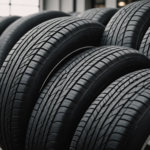Wheels are an integral part of any vehicle, directly affecting performance, safety, and aesthetics. The material from which a wheel is constructed plays a critical role in its functionality. This article delves into the common materials used in automobile wheels, explaining their benefits, drawbacks, and suitable applications. Understanding these aspects can aid in making informed decisions when selecting wheels that fit both personal style and performance needs.
1. Understanding Wheel Materials
The wheel of a car serves several purposes: it supports the vehicle’s weight, facilitates movement, and houses the tires. Consequently, the choice of material affects not only the wheel’s durability but also its weight, performance, and aesthetic appeal. The most common materials used in manufacturing automotive wheels include:
- Aluminum Alloy
- Steel
- Carbon Fiber
- Magnesium Alloy
2. Aluminum Alloy Wheels
Aluminum alloys are among the most popular materials for automotive wheels due to their excellent balance of weight, strength, and aesthetic appeal.
2.1 Benefits of Aluminum Alloy Wheels
- Lightweight: Aluminum wheels are significantly lighter than steel wheels, leading to enhanced fuel efficiency and improved handling.
- Corrosion Resistance: Aluminum naturally forms a protective oxide layer that helps resist corrosion, ensuring longevity even in harsh weather conditions.
- Design Versatility: The manufacturing process of aluminum allows for intricate designs and various finishes, appealing to those who prioritize aesthetics.
- Heat Dissipation: Aluminum has good thermal conductivity, aiding in brake performance by dissipating heat more effectively than other materials.
2.2 Drawbacks of Aluminum Alloy Wheels
- Cost: Aluminum wheels typically come at a higher price point than steel options, which may be a consideration for budget-conscious buyers.
- Durability: While strong, aluminum can be more susceptible to bending and cracking under extreme impacts compared to steel.
3. Steel Wheels
Steel wheels are a traditional choice in the automotive world, recognized for their durability and affordability.
3.1 Benefits of Steel Wheels
- Strong and Durable: Steel is known for its strength, making these wheels highly resistant to impacts, potholes, and other road hazards.
- Cost-Effective: Generally, steel wheels are more affordable than their aluminum counterparts, making them a popular choice for budget-friendly options.
- Repairable: Damaged steel wheels can often be repaired, prolonging their lifespan and value.
3.2 Drawbacks of Steel Wheels
- Weight: Steel wheels are heavier than aluminum, which can negatively impact fuel efficiency and handling.
- Corrosion: Without proper coating, steel wheels can rust, particularly in wet or salty environments.
4. Carbon Fiber Wheels
Carbon fiber wheels are a less common but burgeoning option in the automotive market, especially among high-performance vehicles.
4.1 Benefits of Carbon Fiber Wheels
- Lightweight: Carbon fiber is incredibly lightweight, which allows for enhanced acceleration and handling.
- High Strength-to-Weight Ratio: Despite being light, carbon fiber wheels provide exceptional strength, making them ideal for performance applications.
- Improved Aesthetics: The unique look of carbon fiber adds a modern and high-tech appearance to vehicles.
4.2 Drawbacks of Carbon Fiber Wheels
- Cost: Carbon fiber wheels are typically the most expensive option available, limiting their practicality for everyday vehicles.
- Impact Resistance: While strong, carbon fiber can be more vulnerable to cracking upon high-impact collisions.
5. Magnesium Alloy Wheels
Magnesium alloys are frequently used in motorsports and high-performance applications due to their lightweight properties.
5.1 Benefits of Magnesium Alloy Wheels
- Extremely Lightweight: Magnesium wheels are lighter than aluminum, contributing to better handling and acceleration.
- Heat Dissipation: Magnesium has excellent thermal properties, aiding in better cooling of brake components during high-performance driving.
- Unique Styling: The distinct look of magnesium wheels adds a sporty aesthetic to vehicles.
5.2 Drawbacks of Magnesium Alloy Wheels
- Cost: Similar to carbon fiber, magnesium wheels are often expensive, limiting their accessibility.
- Corrosion Vulnerability: Magnesium is more prone to corrosion unless treated properly, requiring extra care and maintenance.
6. Comparing Wheel Materials
The choice of material is pivotal and should align with the vehicle’s purpose, driving style, and budget. Below is a comparative table summarizing the key aspects of the different materials discussed.
| Material | Weight | Cost | Durability | Corrosion Resistance | Design Options |
|---|---|---|---|---|---|
| Aluminum Alloy | Light | Medium | Moderate | High | Excellent |
| Steel | Heavy | Low | High | Low | Limited |
| Carbon Fiber | Very Light | High | Moderate | High | Excellent |
| Magnesium Alloy | Very Light | High | Moderate | Low | Good |
7. Factors to Consider When Choosing Wheel Materials
Selecting the right wheel material involves more than just understanding their individual characteristics. Here are several factors to consider before making a decision:
7.1 Vehicle Purpose
The intended use of the vehicle heavily influences the choice of wheel material. For instance, a daily driver may benefit more from durability and cost-effectiveness, whereas a sports car would prioritize lightweight materials for performance.
7.2 Driving Conditions
Understanding the environmental conditions in which the vehicle will operate is crucial. Drivers in areas with heavy rainfall, road salt, or high-impact gravel roads should consider materials with superior corrosion resistance or impact durability.
7.3 Aesthetic Preferences
Many car enthusiasts prioritize the look of their wheels. The available design choices vary significantly between materials. Aluminum and carbon fiber offer modern designs, while steel generally lacks aesthetic flexibility.
7.4 Budget Constraints
Ultimately, budget is a significant factor in material choice. While some materials, like aluminum and steel, offer practical options at varying price points, high-performance materials, such as carbon fiber and magnesium, may be cost prohibitive.
8. Conclusion
Understanding the properties of different wheel materials is essential for making informed decisions regarding vehicle performance and appearance. Each material offers unique benefits and drawbacks, making them suitable for various applications. By considering factors such as vehicle purpose, driving conditions, aesthetic preferences, and budget, drivers can select the ideal wheels that not only fit their vehicles but also enhance their driving experience. In the world of automotive customization, information is the key to achieving the perfect balance between style and functionality.












